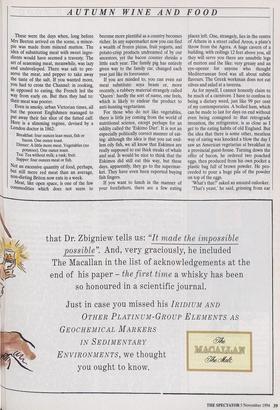Carnivores
Flesh in the pan
Lewis Bessemer
Vegetarians these days are like vegetables: ten a penny. You have to search harder for a carnivore. In this anaemic age, the chances are that even the family dog eats more bis- cuits and more cereal than he eats meat.
There was a time, though, in a poorer age than now, when it was possible to find men who ate little else than flesh; when meat was looked up to as the ideal diet. The concept of guilt had yet to be intro- duced to meal-times.
Here, by way of example, is the menu from an inn called the Sugar Loaf, on Dun- stable High Street, dating from the late- 17th century:
Boiled round of beef Roast loin of pork Roast aitch-bone of beef Boiled hand of pork with pease pudding and parsnips Roast goose Boiled leg of mutton
Not much roughage in that; except, per- haps, if you go for item number four and leave the pork.
England, naturally, was the meat-eating capital of the world. Once the black death had eliminated half of England's mouths- to-feed, many fields became free for graz- ing. By Tudor times there were more English sheep than Englishmen. The wool trade made the country rich and gave East Anglia a fine array of houses built from Flemish bricks, imported as ballast in the boats which had exported wool to Antwerp.
And, of course, the by-product was meat. Not lamb — to have killed a sheep before it had grown its first curly coat would have been sacrilege in a country devoted to the wool trade — but stringy, boiled or stewed mutton. For a hundred years it was our unofficial national dish, and probably accounted for a good half of the bulk of Henry VIII.
AUTUMN WINE AND FOOD
These were the days when, long before Mrs Beeton arrived on the scene, a mince- pie was made from minced mutton. The idea of substituting meat with sweet ingre- dients would have seemed a travesty. The art of seasoning meat, meanwhile, was lazy and undeveloped. There was salt to pre- serve the meat, and pepper to take away the taste of the salt. If you wanted more, you had to cross the Channel: in cooking, as opposed to eating, the French led the way from early on. But then they had to: their meat was poorer.
Even in smoky, urban Victorian times, all but the poorest Englishmen managed to put away their fair slice of the fatted calf. Here is a slimming regime, devised by a London doctor in 1862: Breakfast: four ounces lean meat, fish or bacon. One ounce toast.
Dinner: A little more meat. Vegetables (no potatoes). One ounce toast.
Tea: Tea without milk; a rusk; fruit. Supper: four ounces meat or fish.
Not an excessive quantity of food, perhaps, but still more red meat than an average, non-dieting Briton now eats in a week. Meat, like open space, is one of the few commodities which does not seem to become more plentiful as a country becomes richer. In any supermarket now you can find a wealth of frozen pizzas, fruit yogurts, and potato-crisp products undreamed of by our ancestors, yet the bacon counter shrinks a little each year. The family pig has entirely given way to the family car, changed each year just like its forerunner.
If you are minded to, you can even eat meat substitute: soya beans or, more recently, a rubbery material strangely called 'Quorn': hardly the sort of name, one feels, which is likely to endear the product to anti-hunting vegetarians.
For those who do not like vegetables, there is little joy coming from the world of nutritional science, except perhaps for an oddity called the 'Eskimo Diet'. It is not an especially politically correct manner of eat- ing: although the idea is that you eat end- less oily fish, we all know that Eskimos are really supposed to eat thick steaks of whale and seal. It would be nice to think that the Eskimos did still eat this way, but these days, apparently, they go to the supermar- ket. They have even been reported buying fish fingers.
If you want to lunch in the manner of your forefathers, there are a few eating places left. One, strangely, lies in the centre of Athens in a street called Areos, a plate's throw from the Agora. A huge cavern of a building, with ceilings 12 feet above you, all they will serve you there are unsubtle legs of mutton and the like: very greasy and an eye-opener for anyone who thought Mediterranean food was all about subtle flavours. The Greek workman does not eat olives and salad at a taverna.
As for myself, I cannot honestly claim to be much of a carnivore. I have to confess to being a dietary weed, just like 99 per cent of my contemporaries. A boiled ham, which can be made to last for days on end without even being consigned to that retrograde invention, the refrigerator, is as close as I get to the eating habits of old England. But the idea that there is some other, meatless way of eating was knocked a blow the day I saw an American vegetarian at breakfast in a provincial guest-house. Turning down the offer of bacon, he ordered two poached eggs, then produced from his own pocket a plastic bag full of brown powder. He pro- ceeded to pour a huge pile of the powder on top of the eggs.
`What's that?' asked an amazed onlooker. `That's yeast,' he said, grinning from ear
AUTUMN WINE AND FOOD
to ear. 'It's good for the heart.'
It didn't put me off my food but it put me off fads for life.












































































 Previous page
Previous page